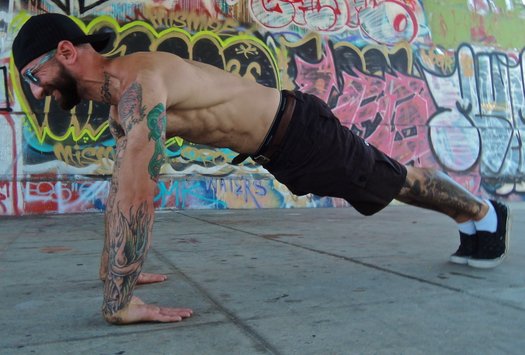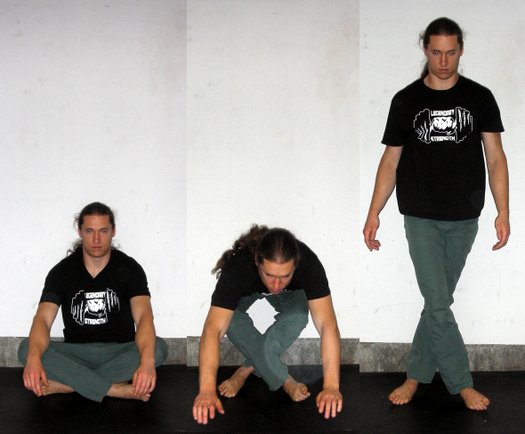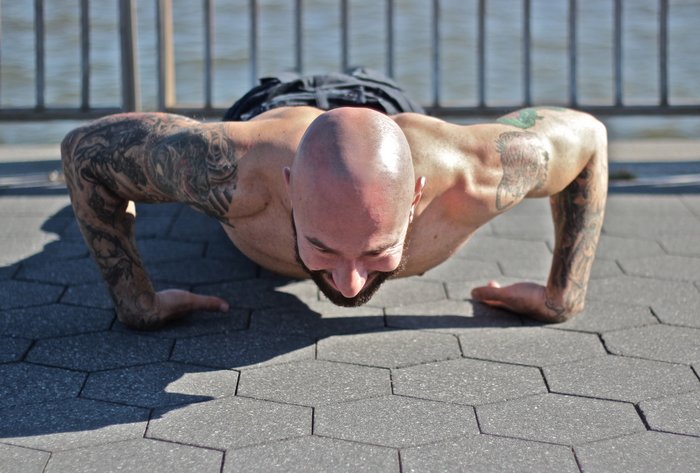
Like many of my generation, I grew up watching movies like The Karate Kid, Kickboxer, Enter the Dragon, Drunken Master, and Rocky. The larger-than-life characters from these films wowed us with their fighting skills and never-give-up attitudes.
A common theme they all share is that the main character is an underdog who must train hard to become a better fighter and overcome his seemingly invincible opponents. The training methods employed often include some tough calisthenics skills. I’m sure we all remember seeing Rocky do uneven pull-ups in the second film, and dragon flags in the fourth. The perseverance of our heroes, the amazing skills they learned, and the rigorous training methods they endured inspired many of us to take up martial arts and training ourselves.
Bruce Lee popularized the dragon flag as well as other difficult bodyweight feats, like his two finger push-ups. He espoused improving your athletic performance in order to improve your martial performance, as well as to help fully express the human body. Certainly, the martial-calisthenics connection is as old as man, yet Bruce was a great catalyst in the popularization of martial arts in America, inspiring many to train hard like he did. He said, “Life is never stagnation. It is constant movement…as well as constant change. Things live by moving and gain strength as they go.”
I didn’t fully understand the implications of these words until I got into Progressive Calisthenics. There are certainly comparisons to be made between learning progressive calisthenics and martial arts. Coach Wade made some of these comparisons in “The Tao of PCC”. He brought up some important similarities to martial arts. “…nobody can remember a hundred techniques in a fight. What matters are the principles you absorb.” “You learn the form, you absorb the form, you discard the form.”
Our training shouldn’t keep us stuck in a rigid form, but instead be directed to the fullest expression of ourselves with utmost efficiency and simplicity. In Jackie Chan’s older films, many of his characters often went through a transformation from a struggling student to a graceful, efficient and powerful athlete. The training was generally harsh, but once he absorbed the principles of his master’s art, he was ready to face the next challenge!
Like the progressive calisthenics approach, traditional power training and body conditioning methods in Okinawan karate focus on bulletproofing the joints, improving flexibility, and building holistic, functional strength.
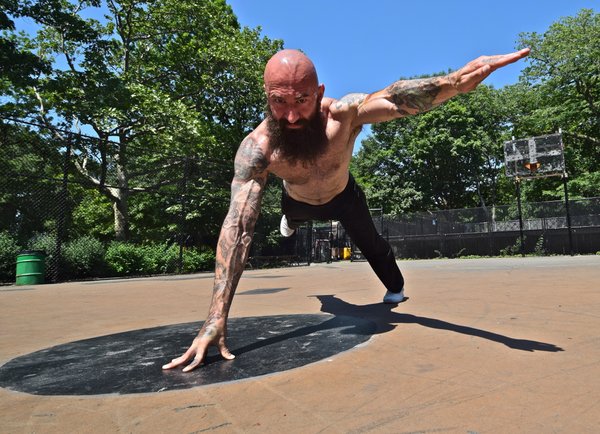
There are a number of progressive bodyweight movements taught in Okinawan karate, including knuckle push-ups, fingertip push-ups and ultimately, wrist push-up variations. The exercises have very direct benefits for “bunkai” or application of kata.
Of course, these exercises shouldn’t replace previous progressions, but supplement them. Also, don’t overdo it with directly training the joints. Be sure to allow plenty of time for your connective tissues to adapt.
To regress any of these variations, you can practice them using an incline (wall, chair etc) or you can simply create less demanding leverage by kneeling instead of performing them from your toes. You could also adapt the Convict Conditioning push-up progression to these variations. (Coach Wade has already covered this for fingertip push-ups in Convict Conditioning 2.)
Warm up your hands and forearms properly before working knuckle, fingertip or wrist push-ups. Afterwards, shake your hands out, and stretch your fingers and wrists.
Like most push-up variations, knuckle push-ups strengthen most of the muscles used in straight punches. Knuckle push-ups also strengthen the wrists and knuckles, and help toughen up the skin. A course of fingertip push-ups, grip work, pull-ups, and proper use of a heavy bag will help you punch as hard as Rocky Balboa!
Fingertip push-ups strengthen the finger extensor muscles. Naturally, they provide direct benefits to strikes using extended fingers. Fingertip push-ups can be progressed by doing push-ups on fewer fingers.
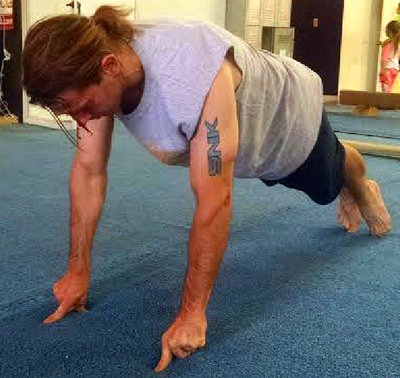
Wrist push-ups strengthen the wrists for various strikes, and have very specific benefits for “ox jaw” and “crane” techniques. This push-up variation is done on the backs of the hands. You can also ease in by having one palm on the training surface instead of having both on the backs of the hands. Practice this way on both sides to maintain symmetry in training.
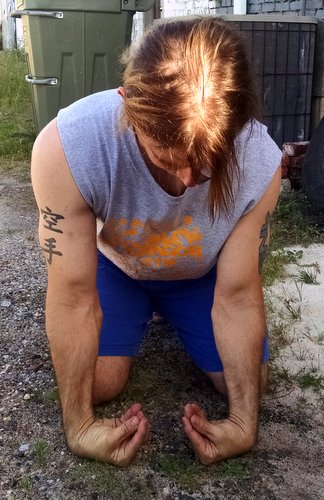
A stretch commonly done in gymnastics will be useful in preparing for a wrist push-up progression. Sit in a kneeling position, look straight down at your knees, lean forward slightly and place the back of your hands on the ground, directly in front of your knees. Naturally, leaning forward will put some of your weight onto the backs of your hands, with the fingers turned inward. Cautiously lean into your hands until you feel mild discomfort. Hold this stretch for 10-30 seconds, then come up and shake your hands out. Repeat 1-3 times.
There are “hidden steps” between this stretch and a wrist hold in the top position of a kneeling push-up. First, gradually build strength and flexibility in the wrists with the stretch until you can put moderate pressure onto the backs of your hands with little to no discomfort. The next part of the progression is to move your hands a few inches forward from the starting position and unfold your hips slightly as you start putting pressure on the backs of your hands. Imagine that you are trying to move a little closer to perfect form for push-ups (hips locked out, weight carried through arms and hands). Find the most difficult position that you can hold for 10-15 seconds when you put mild to moderate pressure on your hands. Gradually work towards the full kneeling push-up wrist hold.
A sample progression:
1. Wall wrist push-ups
2. Incline wrist push-ups with one palm on contact surface and the back of the other hand on contact surface
3. Incline wrist push-ups
4. Kneeling wrist push-ups with same regression as in step 2
5. Kneeling wrist push-ups
6. Hold top of push-up position on backs of hands; use same regression as in steps 2 if needed at first
7. Full push-up with one palm on contact surface and back of other hand on contact surface
8. Full wrist push-ups
Programming and volume for wrist pushups are straightforward. Since the joints don’t adapt as quickly as the muscles, and the wrists can tend to be injury prone, be conservative about volume. Practicing wrist push-ups once a week for low sets of low reps is a good rule.
A few options for programming wrist training:
1) Adding it to an existing joint specialization session; see Convict Conditioning 2 for a template
2) Doing some wrist stretches, holds and/or pushups as part of your warm-ups for practice (whether karate or a sport that needs strong hands/wrists)
3) Doing some light stretches and other exercises as part of rehabilitating your wrists (of course, this will depend on what exercises your physician recommends)
4) Training wrist holds after a session of pushups
5) There are many other possibilities depending on your own needs, goals, experience, etc.
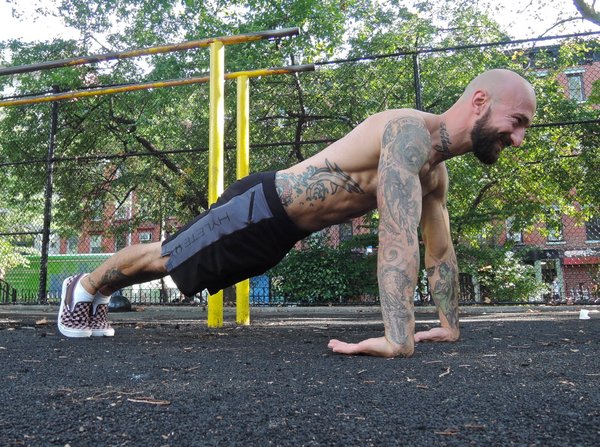
Martial arts and calisthenics can work hand-in-hand to develop all of the qualities needed for the development of strength and technique. I hope that you, dear reader, find my examples of this to be clear and useful. The Okinawan martial arts and the methods that Coach Wade wrote about are ancient, but are still around because they work, and can work well together!
***
Owen Johnston, PCC has served as the strength and conditioning coach at Olympia Gymnastics in Moncks Corner, SC since April 2014, and as a gymnastics coach since August 2014. He began his martial arts journey on June 10th, 2002, and is a black belt instructor. For more information, check out his site, http://www.strengthcalisthenics.com.
